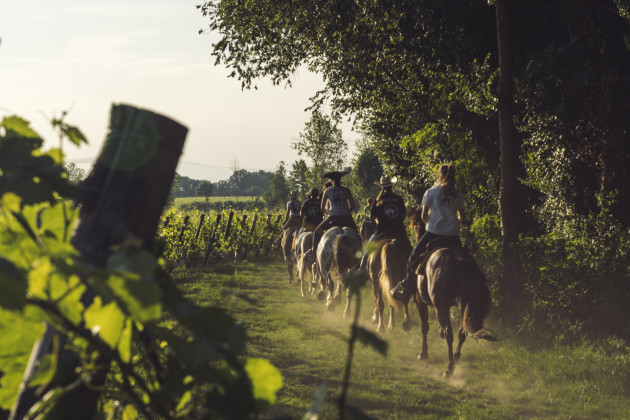
Friday Read: Lugana's long road to the limelight
Lugana, often see as an also-ran compared to the likes of Gavi and Soave, is emerging with new styles, including sparkling, to highlight the distinctive characteristics of the Turbiana grape.
Here, Justin Keay conducts an exclusive interview with the head of the consorzio, discussing how the DOC is reinventing itself, boosting both quality and exports – notably to the UK.
Italian white wine is enjoying a renaissance, led by Soave and Gavi in the north, Verdicchio and Vermintino in the centre and Fiano, Grillo and Caricante in the south. Across the board, quality has never been better as winemakers adapt to growing demand for a drink once seen as secondary to ‘more serious’ red wine. Lugana however, seems to have fallen by the wayside.
- Read more: Garda DOC comes of age
Although the DOC – which straddles Lombardy and Veneto – became Lombardy’s first back in 1967, it has since played a low-key role in the Italian wine scene. Whilst consumers and the trade have rediscovered DOCs such as Soave, with Gavi elevated to DOCG status in 1998 and now viewed as the quintessential Italian white, Lugana received fewer plaudits.
The Oxford Dictionary of Wine of 2015 referred to high yields and “insipid wines often bottled outside the production area”. But by last year, the Hugh Johnson 2022 Wine Guide talked about “much improved whites from south Lake Garda, rivalling good Soave next door”.
For Fabio Zenato, president of the Consorzio Tutela Lugana DOC, this change in perception is no accident. It reflects trends which have been in train amongst the region’s 130-strong producers in recent years, even as production across the region has increased.
“Currently, the denomination is moving forward both in terms of sustainability in the vineyard and in the improvement of cellar practices, aiming at a constant strengthening of the supply chain. We have worked on focusing the identifying characteristics of Lugana: its freshness and sapidity which translate into excellent structure and reflects the terroir,” Zenato says.
He argues that producers across the region’s 2,600 ha have upped their game, not only in quality terms but by introducing new styles, including oak aged vintage Superiore and Riserva wines, rather than the simple, fresh wines for which Lugana is best known. Sparkling wines, made by the Metodo Classico and Spumante methods, and late harvest passito or Vendemmia Tardiva wines, are also on the rise.
What makes Lugana’s renaissance fascinating is that it is clearly very much a work in progress. An online tasting recently organised by the consorzio revealed a very broad taste profile, even in the latest 2022 vintage.
A strong tough-skinned grape with good acidity, Turbiana can be very adaptable. It shows variously in fresh upfront, quite floral almost Sauvignon Blanc style (the Sgreva Lugana DOC Sirmio 2022, for example) to the more mainstream rounded style, suggesting Viognier or Vermintino with apricot, peach and white melon flavours on the palate. A good example here, is new producer’s Poggio al Garda Lugana 2022 and Citari Lugana DOC Conchiglia 2022. This variation is also evident in the bottle shapes, which vary from Bordeaux to Burgundy to Alsatian flute.
Such diversity reflects the DOC’s ownership structure. Almost all the region’s producers are family owned. Unusually for Italy, there are no cooperatives, which in regions like Alto Adige and Abruzzo, have been key in driving the shift towards quality. Benchmark producers including Tommasi, with its Le Farnaci, Zenato with Villa Flora and Monte de Fra with its Lugana Bianco, are clearly acting as guiding lights.
Producers within the DOC, like others fortunate enough to be located on the shores of Lake Garda, have great natural advantages. Located towards the western side of the lake, they benefit from a unique micro-climate, including breezes from the northern mountains in the morning and from the south later in the day. The soils that Zenato refers to – clay, covering mineral rich glacial moraine – along with the characteristics of Turbiana itself – phenolic, full bodied wines, typically at 13-13.5% abv – are also playing a role in Lugana’s evolution.
The decision to call the appellation’s grape Turbiana, rather than the old misnomer Trebbiano di Lugana, has been another positive, giving producers a distinctive calling card.
The biggest factor driving Lugana’s shift to quality seems to be the winemakers themselves, who are no longer happy to sit by and see the DOC remain an also ran in Italy’s white wine renaissance.
Although currently, 90% of wine produced is standard Lugana – generally fermented in stainless steel and released pretty much immediately – there is a distinct shift towards Lugana Superiore and Lugana Riserva, which is oak-aged for at least a year and shows deeper gold colours compared to the light straw colour of standard Lugana, plus more complex aromas and palate.
Most producers are also now making a sparkling Lugana. Amongst those tasted, Montonale Primessenza 2019, made in the classic method (imported by Bancroft Wines) benefits from fantastic acidity and freshness, where ageing brings out complexity. La Rifra and Zamichele Lugana, both produced by the Spumante-Martinotti method and also frankly a joy to drink, show that this category has a huge future ahead of it.
Around 70% of Lugana’s estimated annual 28 million bottles are exported, mostly to markets such as Germany, the US and Japan. However, the consorzio is clearly now taking advantage of the better quality and innovation within the DOC to further raise its profile abroad, particularly in the UK market.
“In 2024 we will invest almost double the budget to improve the knowledge of Lugana wine in England. The activities we foresee will involve the on-trade, the press operators and consumers,” says Zenato.
All of which suggests we should expect to see more Lugana coming this way, very soon.




